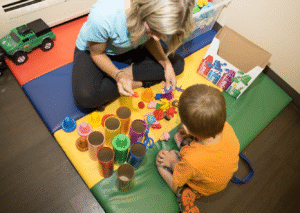As parents, we eagerly await our child’s first words, watching closely as they begin to express themselves through sounds, gestures, and eventually language. However, not all children develop speech and language skills at the same pace, and it’s natural to wonder if your child may need some extra help along the way.
Speech therapy can be critical in supporting children with speech and language challenges, but how can you tell if your child might benefit from it? Understanding the common signs that indicate a potential speech or language delay is the first step to getting your child the help they need.
In this blog, we’ll explore some of the key signs that your child could benefit from speech therapy and what steps you can take if you have concerns.
What is Speech Therapy?
Speech therapy focuses on helping children overcome challenges related to speaking, understanding language, and communicating effectively. A speech therapist (also known as a speech-language pathologist or SLP) works with children to improve various aspects of communication, including articulation, fluency, and comprehension.
When Should You Be Concerned?
It’s important to remember that children develop speech and language skills at their own pace. However, there are general milestones that can help guide your expectations. If your child is not meeting certain benchmarks, it could be a sign that they need additional support.
1. Limited Babbling and Sound-Making (0-12 months)
Even from birth, babies communicate through sounds and gestures. By around 6 months, most babies start making babbling sounds like “ba-ba” or “da-da,” and by their first birthday, they often try to mimic simple words. If your baby isn’t babbling, cooing, or making a range of sounds by 9-12 months, or if they aren’t responding to sounds or their name, it could be a sign of a speech or hearing issue.
2. Lack of Gestures (9-18 months)
Gestures are an important part of early communication. By 9-12 months, most babies will start using gestures like waving, pointing, or reaching to communicate their needs and interests. If your child isn’t using gestures like pointing or waving by 12-15 months, it might indicate a delay in communication skills.
3. Few or No Words by 18-24 Months
By the age of 18-24 months, most children begin to speak more consistently and build a small vocabulary of basic words. They should be able to say simple words like “mama,” “dada,” and other everyday objects or people. If your child isn’t using any words by 18 months or has fewer than 20 words by the age of 2, it’s a good idea to discuss this with a pediatrician or speech therapist.
4. Difficulty Combining Words (24-36 months)
Between 2 and 3 years of age, children start combining two or more words to form simple sentences like “more juice” or “want cookie.” Their vocabulary should rapidly expand during this period. If your child isn’t combining two words by the age of 2 or struggles to follow simple directions (e.g., “get your shoes”), it may indicate a language delay.
5. Unclear or Inconsistent Speech (2-4 years)
By age 3, most children can be understood by familiar listeners (like parents and caregivers) about 75% of the time. By age 4, even unfamiliar adults should be able to understand most of what your child says. If your child’s speech is difficult to understand by age 3, or if they consistently leave out sounds, substitute sounds (e.g., saying “wabbit” instead of “rabbit”), or struggle with articulation, it might indicate a speech sound disorder.
6. Limited Social Interaction or Communication
Speech and language development is closely tied to social skills. A child with language delays may have difficulty engaging in back-and-forth conversations, responding to others, or making eye contact. If your child shows limited interest in interacting with others, avoids eye contact, or doesn’t initiate conversation by age 3, it may be a sign of a language or communication disorder.
7. Stuttering or Repeating Sounds
Fluency issues, such as stuttering or repeating sounds, can become noticeable as children form sentences. While it’s normal for children to go through a brief stuttering phase, especially when they are excited or learning new words, consistent stuttering may require professional support. If your child frequently stutters or gets “stuck” on words beyond age 3, it might be time to consult a speech therapist.
8. Difficulty Understanding or Following Directions
Receptive language skills refer to a child’s ability to understand what others are saying. By 2-3 years old, your child should be able to follow simple directions like “put your toy away” or “come here.” If your child seems to have trouble understanding simple questions or instructions, or they don’t seem to follow conversations, this could be a sign of a language comprehension delay.
Next Steps: What Should You Do If You’re Concerned?
If you’ve noticed any of these signs or if your child’s speech development seems delayed compared to other children their age, it’s essential to take action early. Here’s what you can do:
1. Talk to Your Pediatrician
Your child’s pediatrician is a great starting point. They can help assess whether your child’s speech development is within the typical range and recommend further evaluation.
2. Get an Evaluation from a Speech-Language Pathologist (SLP)
A speech-language pathologist can conduct a comprehensive evaluation to determine if your child has a speech or language delay or disorder. They’ll assess areas like articulation, language comprehension, expressive language, and social communication.
3. Early Intervention
The earlier a speech or language delay is identified, the more effective therapy can be. Early intervention can help your child develop critical communication skills during this important period of brain development.

How Speech Therapy Can Help
Speech therapy is highly individualized and designed to address your child’s specific needs. It may involve a variety of techniques, such as:
- Play-Based Learning: Engaging your child in games, activities, and storytelling to encourage communication.
- Articulation Exercises: Helping your child practice specific sounds or words they struggle with.
- Language Development: Building your child’s vocabulary, understanding of grammar, and sentence formation.
- Social Communication Skills: Teaching your child how to interact with others, take turns in conversation, and understand social cues.
Trust Your Instincts
As a parent, you know your child best. If you have concerns about their speech or language development, don’t hesitate to seek help. Crawl Walk Jump Run Therapy Clinic can help by doing a free screening on your child to assess if they need speech and language services. Early intervention can make a world of difference in helping your child communicate effectively and confidently. Speech therapy offers the tools and support your child needs to overcome challenges and reach their full potential.
If you’re unsure whether your child may benefit from speech therapy, reach out to our team at Crawl Walk Jump Run to schedule an evaluation or discuss your concerns at (586)323-2957. We’re here to support your child’s development every step of the way!




